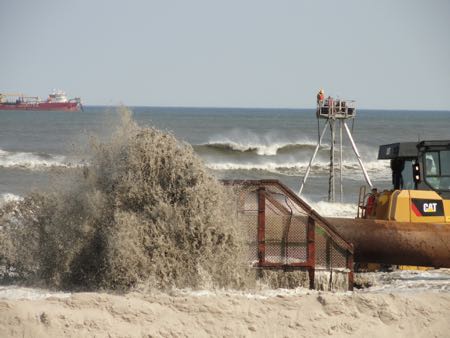
Replenishing 2.6 miles of eroded beaches on the southern end of the island is a massive undertaking involving 1.6 million cubic yards of sand.
That’s enough sand to fill about 200 Olympic-sized swimming pools.
So, where does all that sand come from, and how does it end up on the beach?
To start, a hopper dredge — essentially a ship equipped with trailing suction — named the Liberty Island vacuums sand from the ocean floor in a collection area about two miles off Corson’s Inlet. The dredge’s mechanical arm is shaped like a much larger version of vacuum attachment, covered with an iron grate to keep sea animals such as turtles from being sucked in.
The Liberty Island then heads for a spot off Ocean City, where a buoy marks the end of a floating pipe. That pipe carries sand from the dredge to another pipe that leads to the area where sand is discharged on the beach. There, the mixture of sand and water, called a slurry, travels through a basket designed to screen out unwanted objects such as unexploded munitions. The basket mostly collects seashells, but occasionally an old piece of live ammunition from the years when military training exercises were conducted offshore shows up. The baskets are inspected and emptied after each dredging cycle. Any suspicious objects are turned over to munitions experts to be disposed of, said Richard Pearsall, a spokesman for the US Army Corps of Engineers, which is overseeing the federally funded, $57 million beach replenishment project in Ocean City and in neighboring Strathmere and Sea Isle City.
What comes out of the pipe onto the beach is always a mixture of sand and water to facilitate its flow, but some water is removed on the dredge in order to load more sand. More water is added when the sand is pumped from the dredge to the beach.
Bulldozers with blades 12 to 16 feet wide spread the sand around on the beach and into a template designed by the Army Corps of Engineers.
A three-wheeled vehicle called a coastal research amphibious buggy (CRAB) is used to survey the beach, before and after the dredged sand arrives. It’s a way of measuring how much sand has been deposited, Pearsall said in an email.
The beach replenishment project in Ocean City operates around the clock. The work began last month and is expected to continue until mid-July, from 37th to 59th Street. Great Lakes Dredge and Dock Company of Illinois is the contractor in charge of the project.





